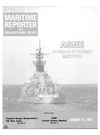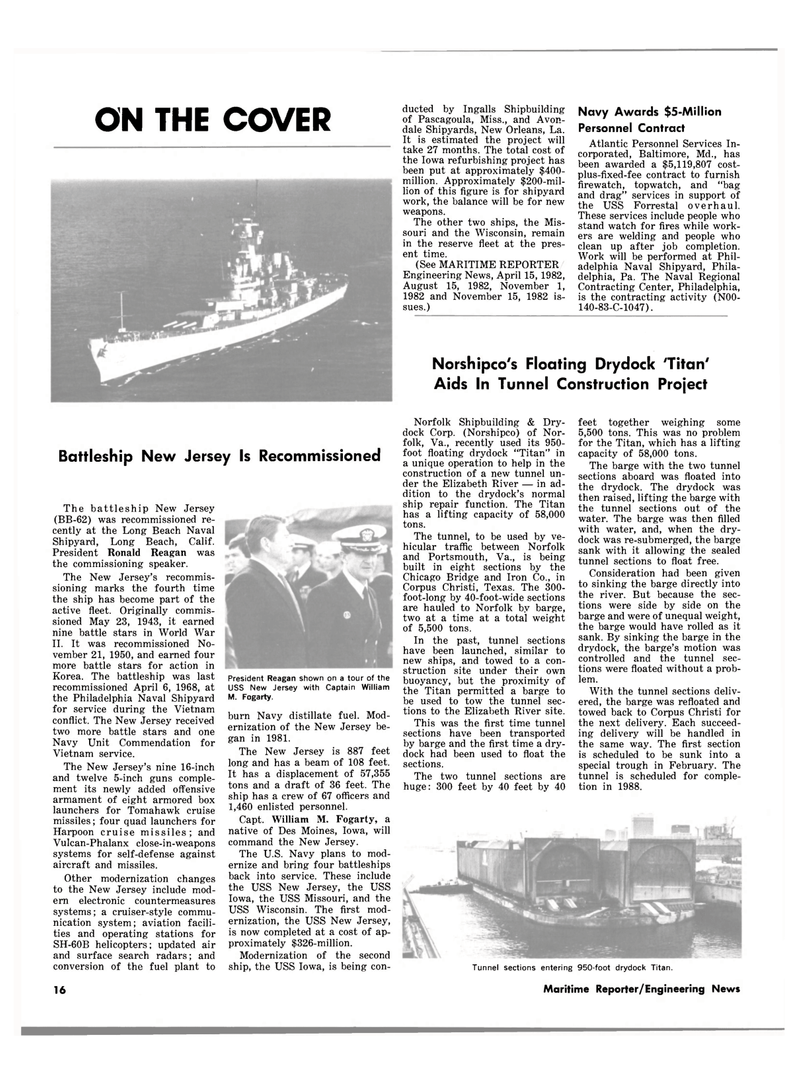
Page 14: of Maritime Reporter Magazine (January 15, 1983)
Read this page in Pdf, Flash or Html5 edition of January 15, 1983 Maritime Reporter Magazine
ON THE COVER ducted by Ingalls Shipbuilding of Pascagoula, Miss., and Avon-dale Shipyards, New Orleans, La.
It is estimated the project will take 27 months. The total cost of the Iowa refurbishing project has been put at approximately $400- million. Approximately $200-mil- lion of this figure is for shipyard work, the balance will be for new weapons.
The other two ships, the Mis- souri and the Wisconsin, remain in the reserve fleet at the pres- ent time. (See MARITIME REPORTER
Engineering News, April 15, 1982,
August 15, 1982, November 1, 1982 and November 15, 1982 is- sues.)
Navy Awards $5-Million
Personnel Contract
Atlantic Personnel Services In- corporated, Baltimore, Md., has been awarded a $5,119,807 cost- plus-fixed-fee contract to furnish firewatch, top watch, and "bag and drag" services in support of the USS Forrestal overhaul.
These services include people who stand watch for fires while work- ers are welding and people who clean up after job completion.
Work will be performed at Phil- adelphia Naval Shipyard, Phila- delphia, Pa. The Naval Regional
Contracting Center, Philadelphia, is the contracting activity (N00- 140-83-C-1047).
Norshipco's Floating Drydock Titan'
Aids In Tunnel Construction Project
Battleship New Jersey Is Recommissioned
The battleship New Jersey (BB-62) was recommissioned re- cently at the Long Beach Naval
Shipyard, Long Beach, Calif.
President Ronald Reagan was the commissioning speaker.
The New Jersey's recommis- sioning marks the fourth time the ship has become part of the active fleet. Originally commis- sioned May 23, 1943, it earned nine battle stars in World War
II. It was recommissioned No- vember 21, 1950, and earned four more battle stars for action in
Korea. The battleship was last recommissioned April 6, 1968, at the Philadelphia Naval Shipyard for service during the Vietnam conflict. The New Jersey received two more battle stars and one
Navy Unit Commendation for
Vietnam service.
The New Jersey's nine 16-inch and twelve 5-inch guns comple- ment its newly added offensive armament of eight armored box launchers for Tomahawk cruise missiles; four quad launchers for
Harpoon cruise missiles; and
Vulcan-Phalanx close-in-weapons systems for self-defense against aircraft and missiles.
Other modernization changes to the New Jersey include mod- ern electronic countermeasures systems; a cruiser-style commu- nication system; aviation facili- ties and operating stations for
SH-60B helicopters; updated air and surface search radars; and conversion of the fuel plant to 16
President Reagan shown on a tour of the
USS New Jersey with Captain William
M. Fogarty. burn Navy distillate fuel. Mod- ernization of the New Jersey be- gan in 1981.
The New Jersey is 887 feet long and has a beam of 108 feet.
It has a displacement of 57,355 tons and a draft of 36 feet. The ship has a crew of 67 officers and 1,460 enlisted personnel.
Capt. William M. Fogarty, a native of Des Moines, Iowa, will command the New Jersey.
The U.S. Navy plans to mod- ernize and bring four battleships back into service. These include the USS New Jersey, the USS
Iowa, the USS Missouri, and the
USS Wisconsin. The first mod- ernization, the USS New Jersey, is now completed at a cost of ap- proximately $326-million.
Modernization of the second ship, the USS Iowa, is being con-
Norfolk Shipbuilding & Dry- dock Corp. (Norshipco) of Nor- folk, Va., recently used its 950- foot floating drydock "Titan" in a unique operation to help in the construction of a new tunnel un- der the Elizabeth River — in ad- dition to the drydock's normal ship repair function. The Titan has a lifting capacity of 58,000 tons.
The tunnel, to be used by ve- hicular traffic between Norfolk and Portsmouth, Va., is being built in eight sections by the
Chicago Bridge and Iron Co., in
Corpus Christi, Texas. The 300- foot-long by 40-foot-wide sections are hauled to Norfolk by barge, two at a time at a total weight of 5,500 tons.
In the past, tunnel sections have been launched, similar to new ships, and towed to a con- struction site under their own buoyancy, but the proximity of the Titan permitted a barge to be used to tow the tunnel sec- tions to the Elizabeth River site.
This was the first time tunnel sections have been transported by barge and the first time a dry- dock had been used to float the sections.
The two tunnel sections are huge: 300 feet by 40 feet by 40 feet together weighing some 5,500 tons. This was no problem for the Titan, which has a lifting capacity of 58,000 tons.
The barge with the two tunnel sections aboard was floated into the drydock. The drydock was then raised, lifting the barge with the tunnel sections out of the water. The barge was then filled with water, and, when the dry- dock was re-submerged, the barge sank with it allowing the sealed tunnel sections to float free.
Consideration had been given to sinking the barge directly into the river. But because the sec- tions were side by side on the barge and were of unequal weight, the barge would have rolled as it sank. By sinking the barge in the drydock, the barge's motion was controlled and the tunnel sec- tions were floated without a prob- lem.
With the tunnel sections deliv- ered, the barge was refloated and towed back to Corpus Christi for the next delivery. Each succeed- ing delivery will be handled in the same way. The first section is scheduled to be sunk into a special trough in February. The tunnel is scheduled for comple- tion in 1988.
Tunnel sections entering 950-foot drydock Titan.
Maritime Reporter/Engineering News

 13
13

 15
15
